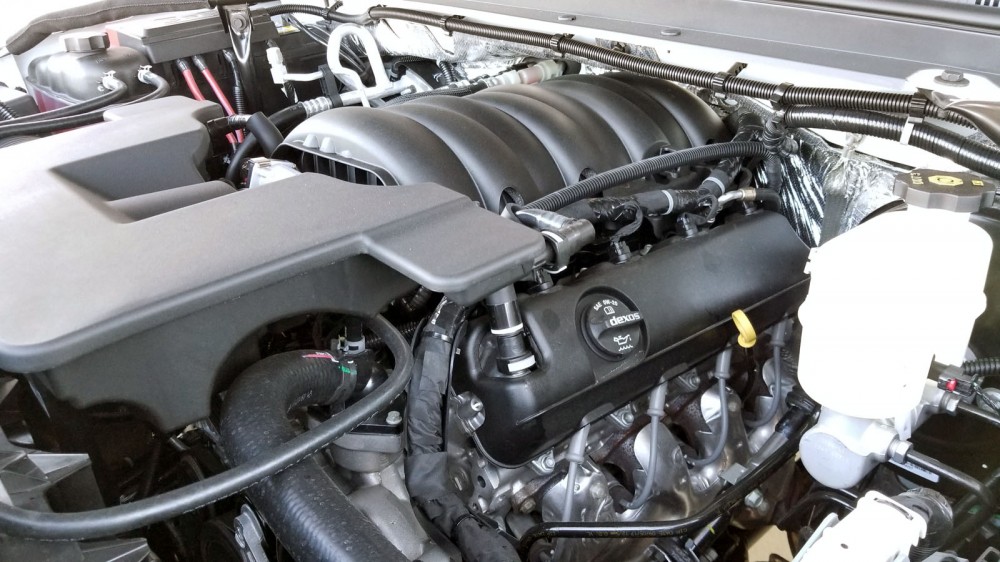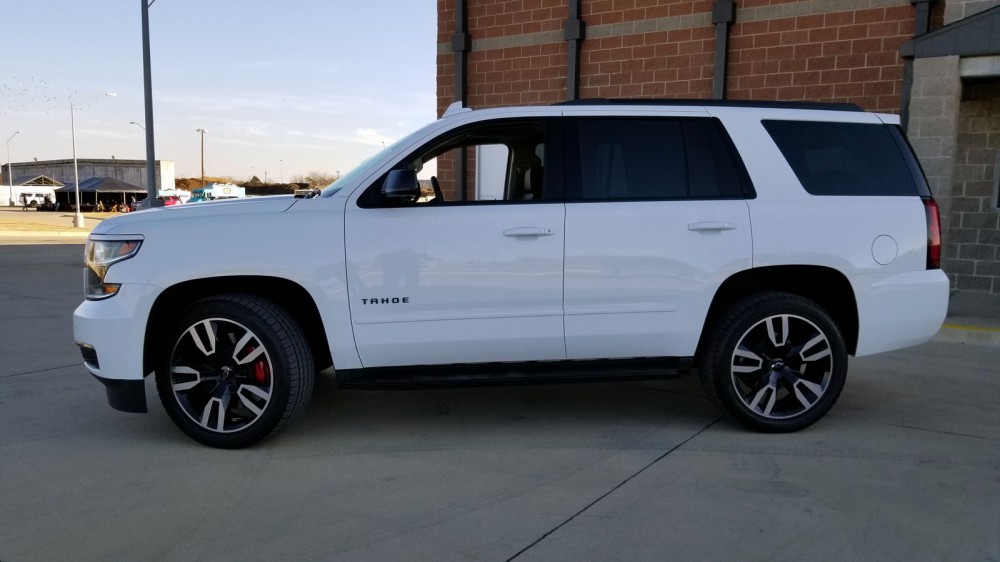Not that long ago, if you needed a three-row vehicle but didn’t want to lose your car enthusiast cred, you were out of luck. Sure, there were big, comfy rides, but nothing that really got your blood going. The world is different now. The Chevrolet Tahoe RST is different.
The Tahoe Rally Sport Truck (RST) is Chevrolet’s hopped-up performance version of its three-row, body-on-frame SUV. It’s powered by an optional 6.2-liter V8 engine making 420 horsepower and 460 pound-feet of torque, which sends power to a four-wheel-drive system via GM’s new 10-speed automatic transmission.
Other RST exclusives include standard Magnetic Ride Control, optional Borla exhaust, and optional Brembo front brakes. The 22-inch wheels are also exclusive to the RST. The rest of the Tahoe is standard Tahoe fare, which is to say that it’s a nice place to be.
As part of Chevrolet’s 100-year anniversary celebration in Texas, we drove the Tahoe RST around the streets of Fort Worth. Driving a Tahoe in Texas is quite fitting — the truck is built in Arlington and Texas is one of the biggest markets for large SUVs. The roads are wide and the speed limits are high.
Driving Impressions
The first thing you notice when hitting the starter button is the big V8. It roars to life, thanks to the Borla exhaust fitted to our example, and is a reminder of just how awesome V8 engines are.
While everyone loves power, the new 10-speed automatic transmission really shines in the RST. The shifts are smooth and quick. It’s based on the automatic transmission available in the Camaro ZL1, and was actually co-developed with Ford, but Chevrolet manufacturers and tunes the transmission itself.
Individual gears are selectable by a toggle switch on the shifter but left to its own devices, the system is pretty good at managing to be in the right gear at the right time.
Combined with the Magnetic Ride Control, the Tahoe RST doesn’t feel like as big or as heavy as it is. Magnetic Ride Control is a trick bit of technology that allows for nearly infinite levels of variability for the suspension tuning. Magnetorheological fluid in each damper responds to magnetic fields. These fields are controlled by a computer. The computer can adjust the apparent viscosity of the fluid thousands of times a second. Basically, Chevrolet can control the stiffness of each damper individually and with nearly infinite variability.
ALSO SEE: 2018 Lincoln Navigator Redefines Large Luxury SUVs
On a large vehicle like the Tahoe, when making a left turn, inertia carries the body to the right. The dampers then increase their stiffness on the right to reduce roll. The results are better handling, even on large vehicles. It’s so effective that the Corvette uses the system, and the same setup is even found on modern Ferraris.
Unfortunately, physics beats technology, so the Tahoe RST still feels big even with the trick suspension and light steering.
The 6.2L V8 engine is naturally aspirated, so there’s no turbo lag keeping the engine from responding when you press the accelerator pedal. Power delivery is linear and the engine likes to rev. It’s a peach of an engine.
It’s also an optional engine that you should check the box for. The standard engine is a 5.3L V8, which we didn’t get a chance to sample, that’s a fine engine by itself but not what we’d want in our performance vehicle.
Outside, the Tahoe RST has blacked-out Chevrolet bowtie badges and blacked-out trim pieces. Interestingly, there are no RST badges anywhere on the exterior of the vehicle. Unless someone knows what they’re looking at, they’ll have no way of knowing that your vehicle is something special.
People buy the Tahoe to use as a tow vehicle, too. The RST is rated to tow up to 8,300 pounds, which is more than enough for most weekend toys and many boats. For people new to towing, Ford’s Pro Trailer Backup Assist in the new Expedition is a nice piece of technology, and unfortunately, the Tahoe doesn’t provide any sort of trailer assistant tech.
Luxury Interior
Inside, the RST we drove was based on the Premiere trim, so it was fully loaded. This included heated and ventilated seats, a power-folding third row, three-zone climate control, and leather-wrapped seats.
With all the seats folded, there is a copious 94.7 cubic feet of cargo volume. One of the appeals of the Tahoe is the sheer size. A competitor like the Durango only has 54.4 cu-ft of space in the same setup.
A color heads-up display helps keep track of your speed and Chevrolet’s MyLink infotainment system is on hand to keep everyone entertained. This includes a relatively simple touchscreen interface and support for Apple CarPlay and Android Auto. Also, OnStar is on hand to help you if you’re in a crash and also includes a 4G LTE hotspot for everyone to stay connected.
Additionally, a flip-down rear seat entertainment system supports Blu-Ray discs as well as other various inputs to connect a gaming system for the long journeys.
Active safety features include a lane departure warning system and forward collision alert. Those alerts can either be audible beeps or a vibration sent through the driver’s seat. Blind spot monitoring helps ensure you don’t lane-change into a Miata you didn’t see.
A rearview camera helps with maneuverability, but there’s no hiding the Tahoe is the size of a battleship. You sit up high and rearward visibility for parking isn’t the greatest. You aren’t going to be parallel parking one of these on the street.
Obvious Drawbacks
There are a few drawbacks with the Tahoe RST that are worth mentioning. Our fully loaded Tahoe RST stickers at $78,450 in the U.S. and doesn’t have adaptive cruise control. While it’s a feature that some people don’t want, it’s more difficult to find vehicles at this price that don’t have it than to find vehicles that do.
The second-row seats fold down at the press of a button from the cargo area, but they aren’t fully powered like the third row. That means you can raise and lower the back row from the buttons in the cargo area, but you have to manually put the second-row seats back into place. If you have to do that regularly, you’ll probably quickly get annoyed.
Finally, we need to talk about the fuel economy. Nobody expects a 420-horsepower V8 to be that fuel efficient, especially in a vehicle this size, but even with the 10-speed automatic, the best it can do on the highway is 22 mpg. It drops off to 14 mpg in the city for a combined rating of 17 mpg.
The obvious competitor to the Tahoe RST is the three-row Dodge Durango SRT, which makes 475 hp and 470 lb-ft of torque. It also beats the Tahoe’s 8,300-pound towing capacity by 400 pounds. The Durango SRT is also less money.
The Durango, however, doesn’t have nearly as much storage or seating capacity as the Tahoe. Also, the Tahoe has better off-road capability.
The Verdict: 2018 Chevrolet Tahoe RST Review
Despite the drawbacks, the Tahoe RST is a solid SUV that handles and feels like a proper truck. It has enough storage for all of your weekend gear, and it has the capability to take you to your campsite regardless of where it is.
Does it live up to the RST badge? It’s a fun vehicle for those who need something Texas-sized. But you also don’t need to order the RST to get a Borla, or any, aftermarket exhaust. But the modifications do come with a factory warranty.
The V8 rumble is intoxicating and the under-the-radar design of the Tahoe RST means you’ll be able to avoid law enforcement attention. If you’re in the market for a performance SUV, you may want to give the Tahoe RST a look.
Discuss this article on our Chevrolet Trucks Forum











